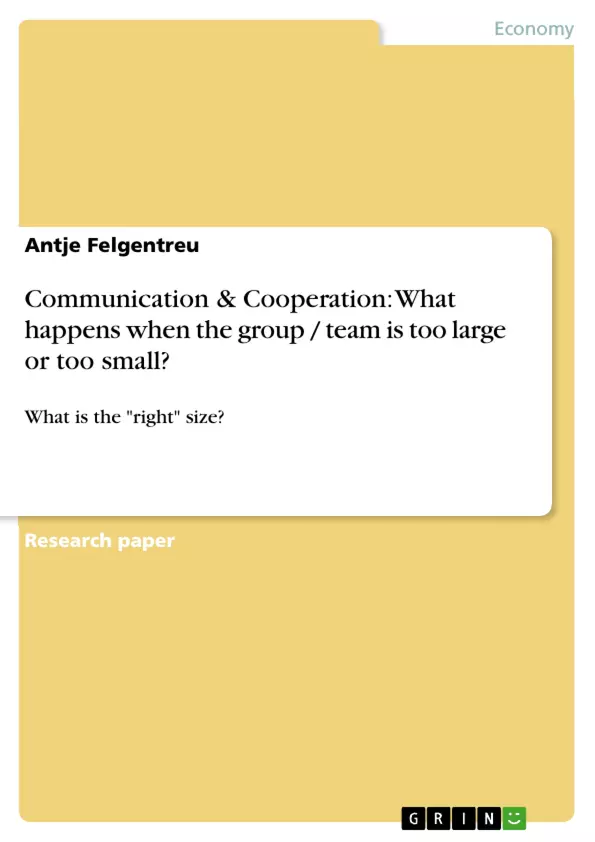The size of a group is a topic with which we each day is unconsciously occupied. If we rise e.g. after a long working day into the overcrowded bus home, then is fast conscious to us: the group is too large. If we cannot master our tasks on the job punctually, we wish ourselves reinforcement. Everyone is each day in a multiplicity of groups: Family, friends, teammate etc. nevertheless: Does it really concern thereby groups? With this question I would like to deal in chapter 2 more in greater detail. There one describes, by which components a group is characterized. Thereupon become in the 3. chapter different group sizes formally and during the process more exactly regarded. All these scenarios suggests that the group has emergent properties which go beyond the individuals who comprise it.
Starting from chapter 4 I will be occupied further with the work with smaller groups. The data resulting from it can be used then likewise for the work with larger group - by the organization by sub-groups. At first we will regard, how to use small groups to promote interaction within the class as a whole. This chapter should be an assistance for understanding group phenomena and group processes. Beyond that suggestions given for the line of the group. Finally the also following phenomena are supplemented: how to use groups to syndicate discussions of questions or cases and how to use groups for substential project work. In the last chapter I give a summary and a view to the treated topic.
Inhaltsverzeichnis (Table of Contents)
- Introduction
- Characterisation of groups
- Analysis of different group sizes
- Group participants: 1-3
- Group participants: 4-8
- Group participants: 12-150
- Small Group Working
- Use small groups to promote interaction within the class as a whole
- Use small groups for syndicate discussions of questions or cases
- Use small groups for substantial project work
- Summary and Conclusions
Zielsetzung und Themenschwerpunkte (Objectives and Key Themes)
This essay aims to explore the impact of group size on communication and cooperation, examining how different group sizes affect individual and group dynamics.
- Defining and characterizing groups
- Analyzing the influence of group size on interaction and performance
- Exploring the benefits and challenges of working in small groups
- Identifying factors that impact group size
- Understanding the implications of group size for communication and cooperation
Zusammenfassung der Kapitel (Chapter Summaries)
- Introduction: Introduces the concept of group size and its relevance in daily life. It highlights the multifaceted nature of groups and sets the stage for exploring different group sizes and their characteristics.
- Characterisation of groups: Defines the key characteristics of a group, emphasizing the presence of a collection of people interacting with each other, aware of each other's presence. It introduces the concept of group size as a factor influencing group dynamics.
- Analysis of different group sizes: This section examines various group sizes, starting with groups of 1-3 individuals. It explores how group dynamics and individual behavior vary across different group sizes.
- Small Group Working: This chapter delves into the benefits and applications of small groups in various contexts, including promoting class interaction, facilitating syndicate discussions, and undertaking substantial project work.
Schlüsselwörter (Keywords)
This essay focuses on the interplay between group size, communication, and cooperation. Key concepts include group dynamics, interaction, performance, group size analysis, small group working, and the benefits and challenges of different group sizes.
- Citation du texte
- Antje Felgentreu (Auteur), 2005, Communication & Cooperation: What happens when the group / team is too large or too small?, Munich, GRIN Verlag, https://www.grin.com/document/91987



